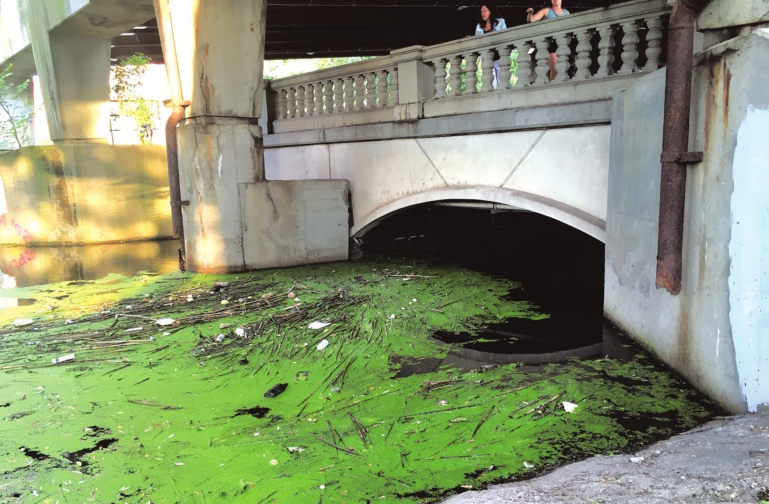
The Muddy River has received a D- score on The Charles River Watershed Association (CRWA)’s annual water quality report for 2020, with all other areas of the Charles River watershed earning A and B grades.
A D- grade means the Muddy River failed to meet Massachusetts water quality standards for swimming and boating for 55% to 60% of both the wet and dry seasons. The main factors volunteers looked for were the presence of E. Coli and Cyanobacteria, with a failure marked on any day the levels were high enough to pose a health risk to humans.
“You wouldn’t want to swim in it,” said Emily Norton, Executive Director for the Watershed Association. “Particularly when there’s Cyanobacteria, dogs are killed when they get in and drink the water. It’s dangerous to have contact with it and according to some studies even to breathe near it.” The annual report’s
data is collected by around 80 volunteers. Once a month, samples are
collected at 35 different sites and tested for hazardous elements. Muddy
River has long been a problem area as one of only two tributary sites
measured by the Watershed Association.
“Tributaries
often have higher pollution because they lack the dilution effect of
the river’s main stem,” said Lisa Kumpf, the CRWA’s aquatic scientist.
“The
land use around the area is also highly urbanized, with the watershed
covering Brookline Avenue and part of Newton. Several storm sewer
systems go into the Muddy as well as one Combined Sewer Overflow
discharge site.”
Pollution
along Muddy River goes back decades and was one of the challenges the
Emerald Necklace Conservancy was founded to address in 1996.
“The
Emerald Necklace Conservancy was born over concerns about the Muddy
River,” said Karen Mauney-Brodek, the Conservancy’s president. “There’s a
real need to focus on water quality. Land and river aren’t separate,
even if regulators treat them as such.”
Kumpf
indicated that the main source of E. coli pollution in the Charles
River watershed is storm runoff, which the CRWA hopes to counteract with
beds of local plant life around stormwater discharge sites. Green
stormwater infrastructure naturally filters the grey water through the
soil, isolating and purifying contaminants so that the river receives
clean water.
The CRWA
has been lobbying local governments to alert residents of sewage
releases and has set up its own alert service for poor water quality.
Muddy River has also been the site of a restoration project from the
Army Corps of Engineers since the late 1990s in the interest of flood
control. A first phase opened up a section of the Muddy River to
sunlight and air in 2016, and the current second phase consists of
dredging. The process started last fall and aims to both improve
filtration and clear habitat to be reclaimed by local wildlife, further
filtering the water.
The
Emerald Necklace Conservancy is planning to clear the last areas still
choked by 15-foot-tall groves of invasive phragmites reeds after the
Army Corps’ two-year second phase. It also has its sights set on
daylighting Charlesgate, the connection between Muddy River and the
Charles River. “The last 250 feet of the river is in a pipe from the
1950s,” said Mauney-Brodek.
“They’re
old, they’re full of gunk, and the D-rating is taken just north of
that, so it might be an F in the middle of those pipes.”
There
could be much more work to be done around other Charles River
tributaries. The CRWA’s sampling efforts only began giving its two
measured tributaries discrete grades in 2019, and over 30 other
tributaries go unmeasured due to a lack of funding.
“We don’t have the capacity to do sampling in every tributary. I wish we did, but we just don’t,” said Norton.